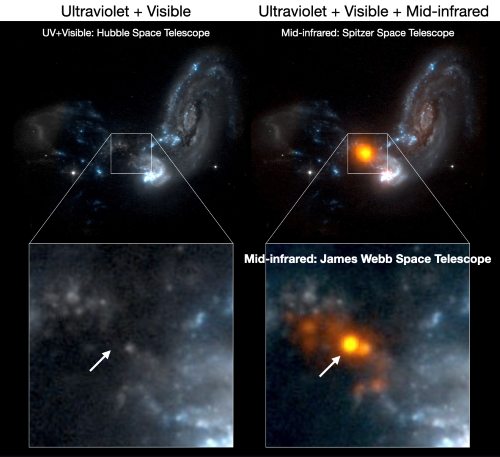The collision between two or more galaxies is a common occurrence in space. But what is the driving force behind the merging of these galaxies?
With the help of NASA's James Webb Space Telescope, an international team of astronomers unveiled for the first time the "invisible" engine between two galaxies that are in the middle of a collision, according to Hiroshima University's press release.

Pinpointing Engine's Location
The two galaxies were colliding 500 million light-years away in the constellation Delphinus. They are known as merging galaxy IIZw096.
The team found the exact location of this powerful source outside the main parts of the colliding galaxies. It was already observed by the Hubble Space Telescope in ultraviolet and visible light before but it was unable to unveil the invisible force.
Now, Webb's powerful infrared vision and advanced capabilities helped astronomers to trace the precise location of the "engine" driving the merging galaxy.
The team found that the engine was responsible for up to 70% of the total infrared emission of the system. They also discovered that it has a radius no larger than 570 light years, which is only a small portion of the merging system that spans 65,000 light-years across.
According to the study's co-author Thomas Bohn at Hiroshima University, the engine's power is confined to a tiny space yet it dominates the infrared luminosity of the system.
Bohn said that the source is like a speck of pepper on the white of an egg but it still makes a huge contribution to the merging galaxies with its infrared power.
The astronomers will use Webb's infrared spectra to find what powers this invisible engine, particularly if it is a starburst or a massive black hole.
Bohn also noted that it is unusual how the engine is found outside the main parts of the galaxies. Hence, the team will be investigating how the powerful source ended up in its current location.
Read also : NASA's James Webb Space Telescope Catches an 'Asteroid Photobomber' Roughly the Size of Rome's Colosseum
12 Clumps of Light
The researchers were also able to locate 12 clumps of light in addition to unveiling the engine's location. Five of these were discovered for the first time using the James Webb Space Telescope, however, several of them had already been identified by Hubble's near-infrared vision before.
It is also worth noting that the merging galaxies were found 12 years ago by the same team with the help of the Spitzer Space Telescope. They were able to measure the engine's power through its brightness but were unable to pinpoint its locations because of Spitzer's limited capabilities.
"The James Webb Space Telescope mid-infrared imaging described in this paper revealed a hidden aspect of the merging galaxy IIZw096 and opened a door towards identifying heavily dust-obscured sources which cannot be found at shorter wavelengths," co-author Hanae Inami of the Hiroshima University said in a statement.
"Future planned spectroscopic observations of IIZw096 will provide additional information on the nature of the dust, ionized gas, and warm molecular gas in and around the disturbed region of this luminous merging galaxy."
The study's findings were published in The Astrophysical Journal Letters.
Related Article : NASA's James Webb Space Telescope Snaps an Incredibly Detailed View of a Crowded Field of Galaxies

ⓒ 2025 TECHTIMES.com All rights reserved. Do not reproduce without permission.




